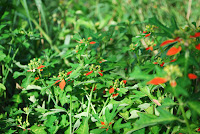________________________________________

East coast dune sunflower (Helianthus debilis, Asteraceae)
Native
Large patches grow along the ditch banks. We use it as a low-maintenance ground cover around part of our pool deck.
________________________________________
Sandbur (Cenchrus spp., Poaceae)
Native
A large, coarse sandbur; few, long stems ending in burs; possibly Cenchrus gracilis, slender sandbur.
________________________________________


Corkystem passionflower (Passiflora suberosa, Passifloraceae)
Native
This vine grows on our chainlink fence.
________________________________________
Whitemouth dayflower (Commelina erecta, Commelinaceae)
Native
Stems round along the ground. One of the prettiest "weeds." Seeds eaten by doves and songbirds, according to W.K. Taylor.
________________________________________

Dwarf Canadian horseweed (Conyza canadensis var. pusilla, Asteraceae)
Native
________________________________________

Mascarene Island leafflower (Phyllanthus tenellus, Phyllanthaceae)
Not native
This weed pops up in bare places along our roof drip line. A new species for me. Tiny, star-shaped, greenish-white flowers grow along the compound leaves. Native to Africa and the Mascarene Islands. A weed of greenhouses and container ornamentals. W.K.Taylor shows this as belonging to the spurge family, Euphorbiaceae. I assume the USF/ISB designation of Phyllanthaceae is the currently accepted family.
________________________________________

Painted leaf, fire-on-the-mountain (Poinsettia cyathophora, Euphorbiaceae)
Native
Also known as wild poinsettia.
________________________________________
Little hogweed (Portulaca oleracea, Portulacaceae)
Not native
Commonly known in the U.S. as purslane or pusley. Can be eaten as a nutritious leaf vegetable. It has a slightly sour and salty taste. Can be used as a salad, stir-fried, or cooked like spinach.
________________________________________
Beggarticks, Spanish needles (Bidens alba, Asteraceae)
Native
The bizarre, spiny insect on the blossom is a plume moth.
________________________________________

Red spiderling, wineflower (Boerhavia diffusa, Nyctaginaceae)
Native
________________________________________
Graceful sandmat (Chamaesyce hypericifolia, Euphorbiaceae)
Native
________________________________________
Hyssopleaf sandmat (Chamaesyce hyssopifolia, Euphorbiaceae)
Native
________________________________________
Tread-softly, finger-rot, stinging nettle (Cnidoscolus stimulosus, Euphorbiaceae)
Native
Native
________________________________________


























































